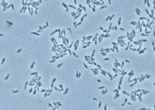|
AN INTRODUCTION TO GENOMICS:
THE HUMAN GENOME AND BEYOND
Genomics Applications
Fighting Disease
Some human diseases and defects are directly or indirectly caused by genetic abnormalities. Sickle cell anemia, for example, is caused by a change in just one nucleotide out of six billion. Specific genes have been associated with breast cancer, deafness, and blindness. Some illnesses are caused by complex, interacting environmental and genetic factors and cannot be explained by classical inheritance patterns. Genome studies help medical researchers understand the molecular details of these diseases so they can pursue innovative drug treatments and more quickly identify high-risk individuals who could benefit from early medical intervention. And the analysis of the genomes of disease-causing microbes, viruses, and insects, such as the human malaria parasite and its carrier, the Anopheles mosquito, are helping in the development of new prevention and treatment strategies.

Most cystic fibrosis is from one DNA mutation—deletion of just 3 nucleotides—causing buildup of large amounts of mucus in the lungs.
Harnessing nature's technology
Microbes—nature's simplest and most abundant organisms—can thrive under extreme conditions of heat, cold, pressure, and even radiation. By studying their genomes, scientists hope to find ways to use bacteria and other microorganisms to solve a variety of environmental problems, develop new energy sources, and improve industrial processes. Some microbes can help clean up hazardous waste sites by absorbing, transforming, or breaking down contaminants—a technique called bioremediation. Others can help combat global warming by absorbing, or sequestering, carbon from the atmosphere. And microbes can convert a wide range of organic and inorganic materials into renewable energy.

The bacterium Rhodopseudomonas palustris can degrade complex aromatic hydrocarbons, assimilate carbon, and provide insights into biomass and biofuel production, particularly hydrogen.
Information taken from the Joint Genome Institute: Joint Genome Institute authored documents are sponsored by the U.S. Department of Energy under Contracts W-7405-Eng-48, DE-AC02-05CH11231, and W-7405-ENG-36. Accordingly, the U.S. Government retains a nonexclusive, royalty-free license to publish or reproduce these documents, or allow others to do so, for U.S. Government purposes. All documents available from this server may be protected under the U.S. and Foreign Copyright Laws and permission to reproduce them may be required. The public may copy and use this information without charge, provided that this Notice and any statement of authorship are reproduced on all copies. JGI is not responsible for the contents of any off-site pages referenced.
Go to next section
Printer-friendly page
All content © 2006-08 by Lori Andrews.
loriandrews.com |
